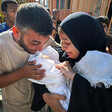Rights and Accountability 20 July 2018

An Israeli airstrike in Khan Younis, southern Gaza, on 20 July.
APA imagesIsrael pounded the Gaza Strip with airstrikes and artillery fire Friday night after dropping some 50 tons of munitions on the territory over the past week.
An Israeli soldier and three Palestinian fighters were killed during exchanges of fire on Friday, according to reports.
The Qassam Brigades, the military wing of Hamas, said that its fighter Mahmoud Khalil Qishta was killed at an observation post in eastern Rafah in Gaza’s south: Fighters Muhammad Riyad Abu Farhana and Shaaban Rajab Abu Khater were killed at an observation post east of Khan Younis, also in southern Gaza: A fourth Palestinian, Muhammad Badwan, 24, was reported killed east of Gaza City on Friday. He was shot in the chest while participating in a protest.Earlier on Friday Israeli defense minister Avigdor Lieberman threatened a “broad, painful military operation” in Gaza.
Civilians to “pay the price”
Lieberman indicated that Israel would once again target civilians in any new major operation in order to exact political concessions from Hamas.
“Unfortunately, residents of Gaza will be among those who will have to pay the price,” the defense minister stated.
He also said that the operation would be “more painful than Operation Protective Edge,” the devastating assault Israel waged in summer 2014.
More than 2,250 Palestinians were killed during that assault – about one in every 1,000 Gaza residents. Israeli fatalities included nearly 70 soldiers and six civilians.
About two-thirds of all Palestinians killed during the 51-day operation were civilians, who “paid the heaviest price,” according to the chair of a United Nations special committee to investigate Israeli practices impacting Palestinian human rights.
The “unacceptably high ratio” of Palestinian civilian casualties could not be dismissed as “collateral damage,” Hussein Haniff stated in 2014.
On Friday, Lieberman, who oversees Israel’s military forces, inadvertently confirmed that he makes no distinction between civilians and combatants killed during the ongoing crackdown on popular protests along Gaza’s eastern boundary.
“There are 159 dead terrorists, there are some 5,000 wounded,” Lieberman said.
The principle of distinction between civilians and combatants is the first rule of international humanitarian law governing armed conflict.
Lieberman’s statements could therefore potentially be viewed as evidence of intent to commit war crimes by International Criminal Court prosecutors currently examining the situation in Gaza.
In reality, most of the more than 150 Palestinians killed by Israel since the launch of the Great March of Return protests on 30 March were unarmed demonstrators.
Seventeen children were fatally wounded during the protests, as were two journalists and two paramedics who were targeted while on duty during the protests.
Before a soldier was killed on Friday, no Israelis had been killed in the context of the protests or as a result of any activity from Gaza since well before 30 March, the launch of the Great March of Return.
The ongoing series of protests is aimed at bringing an end to the siege and affirming the right of Palestinian refugees to return to their lands of origin from which they were expelled and upon which the state of Israel was declared in 1948.Human Rights Watch has described Israel’s open-fire policy towards Gaza protesters as “calculated” and Amnesty International has termed it a “murderous assault.”
The use of live fire against unarmed demonstrators has also attracted the scrutiny of the International Criminal Court and Israeli leaders have received an unprecedented warning from the chief prosecutor.
Dahiya doctrine
Israeli leaders have repeatedly declared their intention to launch a large-scale military operation in Gaza to “create durable deterrence,” as stated by public security minister Gilad Erdan.
Such declarations suggest tactics similar to Israel’s “Dahiya doctrine,” named after the southern suburb of Beirut which it subjected to indiscriminate bombing during the Israeli invasion Lebanon in 2006.
An independent UN-commissioned inquiry into Israel’s attack on Gaza in 2008-2009 described the Dahiya doctrine as “the application of disproportionate force and the causing of great damage and destruction to civilian property and infrastructure, and suffering to civilian populations.”
With the disproportionality that is the hallmark of Israeli military strategy, the army has responded to the Great March of Return protests and the new Palestinian tactic of incendiary balloons and kites with massive and deadly force.
Erdan had previously said that the military should shoot Palestinians launching burning kites and balloons from Gaza, even if they are children.Last Saturday, Israel carried out punitive airstrikes across Gaza that killed two 14-year-old boys playing on the roof of an empty building in the heart of Gaza City, after Israel said one of its soldiers was injured by an explosive thrown from Gaza.
News reports suggested that armed groups in Gaza would agree to stop launching incendiary kites and balloons if Israel and Egypt would ease the blockade on the territory.
But earlier this week Israel announced the full closure of Gaza’s sole commercial crossing, which it controls. This is on top of tightened restrictions imposed the week before.
“This measure blocks the entry of fuel and cooking gas supplies, allowing only medicines and food items to pass into Gaza after approvals of shipments one-by-one,” the Gaza-based human rights group Al Mezan stated.Gaza already contends with a chronic electricity shortage resulting in blackouts of more than 20 hours per day.
Al Mezan warned that Gaza’s hospitals, already in acute crisis as a result of Israel’s open-fire policy, would face serious operational difficulties if the tightened restrictions last more than a few days.
Nonfunctioning hospitals would mean the entry of any medicines would have little benefit, Al Mezan added.
The rights group also condemned the “inaction of [the] international community concerning the aggravating closure and blockade Israel has been imposing on the Gaza Strip for over 11 years.”
Disastrous deterioration
The United Nations humanitarian coordinator in the occupied West Bank and Gaza Strip also decried the new Israeli measure, warning of “a disastrous deterioration, with potential broad impacts not only on Palestinians in Gaza, but the region.”
“Everyone with the ability to improve the situation must take a step back, prevent further escalation and reduce the suffering of ordinary Palestinians in Gaza,” Jamie McGoldrick added.
Meanwhile nearly two dozen Palestinian, Israeli and international human rights groups are calling on the European Union to “clearly recognize Israel’s primary responsibility over the unlawful closure and blockade of the Gaza Strip” and take action to ensure its “immediate and unconditional end.”
A United Nations human rights expert stated last week that “imposing even greater social and economic harm on Gaza will not address Israel’s true security interests, and it profoundly violates the rights of the residents of Gaza.”
Michael Lynk added: “Only through the economic restoration of Gaza, and a guaranteed path for Palestinian self-determination and the end of the Israeli occupation, will tensions ease between Gaza and Israel. Collectively punishing the entire population of Gaza, and further isolating it from the world, is exactly the wrong path – legally, politically and morally.”
Meanwhile Palestinians took to social media to document Israel’s new assault on Gaza and to describe how they and their families were coping:
Israeli officials like Lieberman claim there is “no choice” but to use massive force against Gaza.But Israel’s own military commanders have downplayed the balloons and kites, the stated reason for the tightening of the siege and the brinkmanship between Israel and Hamas.
“All the whining about the kites drives me crazy,” a senior officer told the Israeli paper Haaretz in a story published Friday. “It’s also the complete opposite of what you hear from most of the people who live here [in areas affected by the balloons and kites].”
Israel’s wars of choice
Any major attack on besieged and imprisoned Gaza will – just like the last one – be another of Israel’s wars of choice aimed at maintaining Israeli ascendancy through the violent, permanent subjugation of millions of Palestinians.
And like in 2014, the goal of an attack on Gaza will be to pacify its population – two-thirds of them refugees denied their right to return, living under siege for more than a decade and under military occupation in one of the most densely populated places in the world for half a century.There is no reason to believe Israel will succeed with that objective in 2018, but given the unfathomable human suffering it would entail, it must not be allowed to try.
This story was updated to clarify the circumstances of Muhammad Badwan’s killing and to change the number of Palestinian fighters killed on Friday from four to three.





Comments
Israel
Permalink John A. El-Amin replied on
Where are the actions and voices of the "international community" to STOP Israel's murder of the Palestinian people?
Why tithe silence to this organized evil of the new Holocaust?